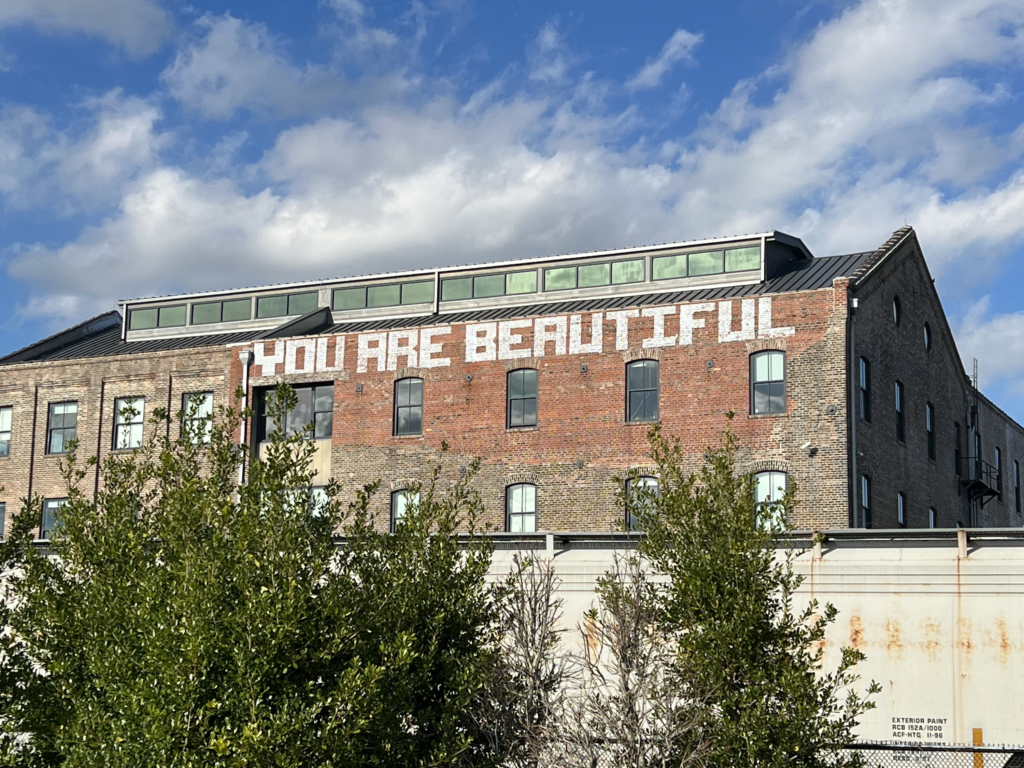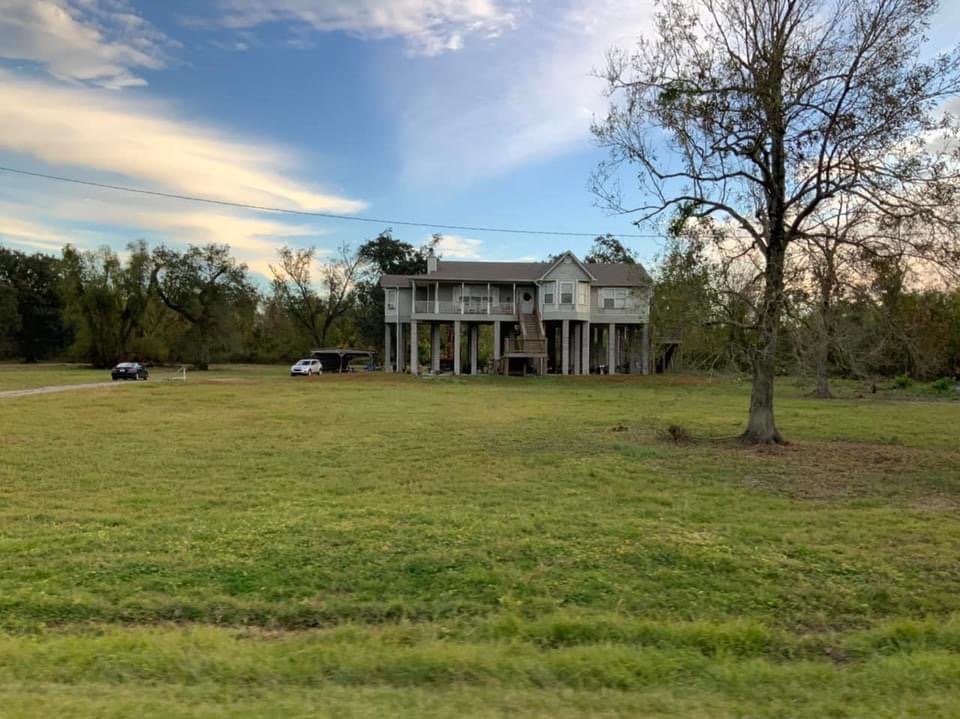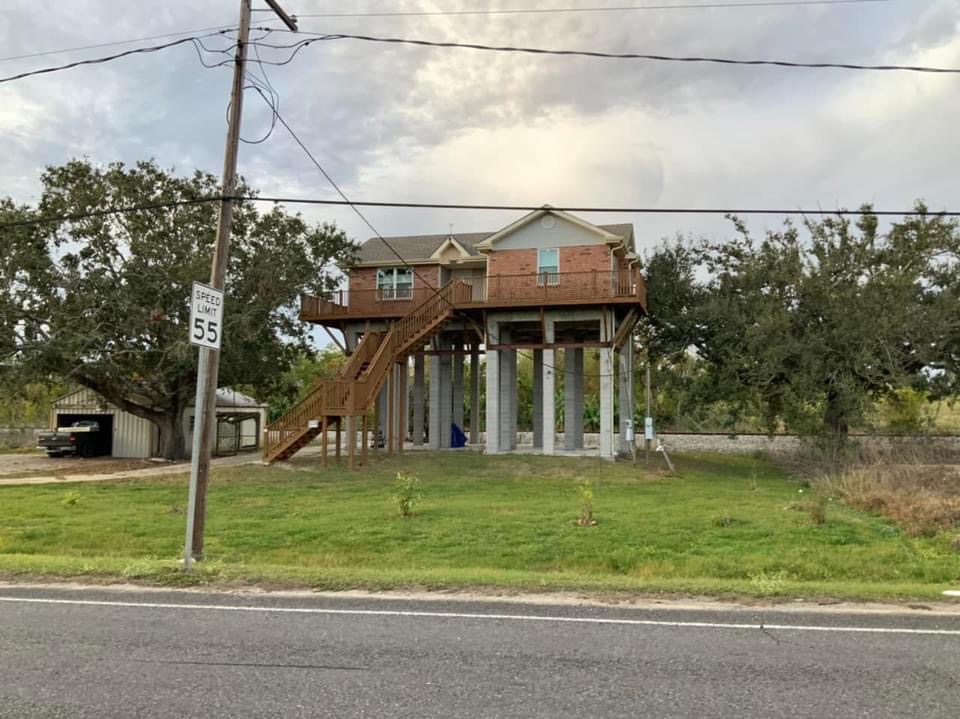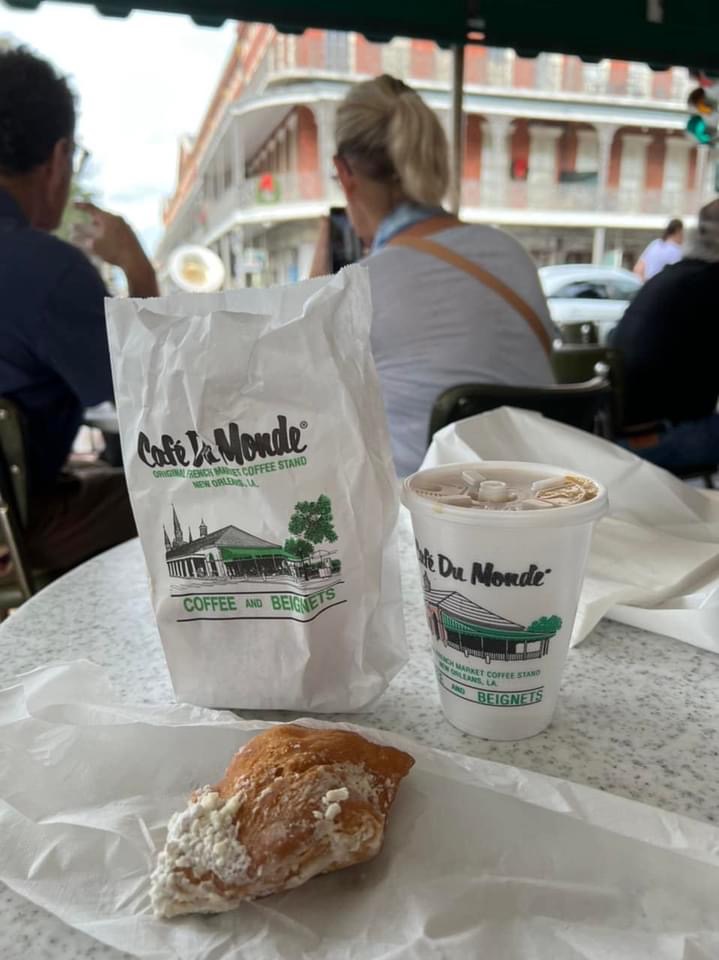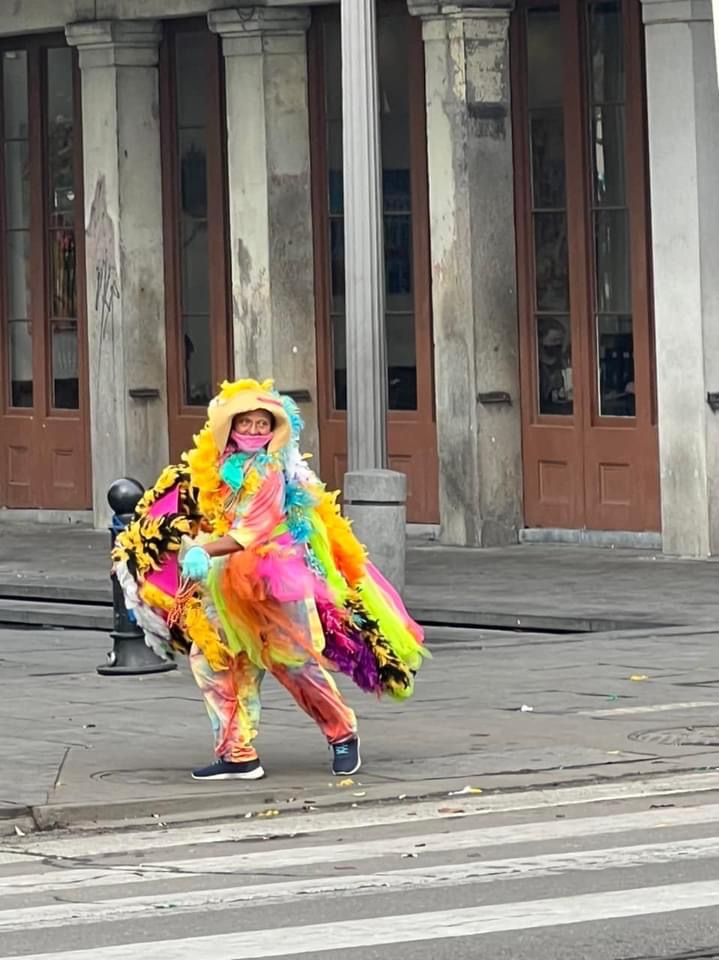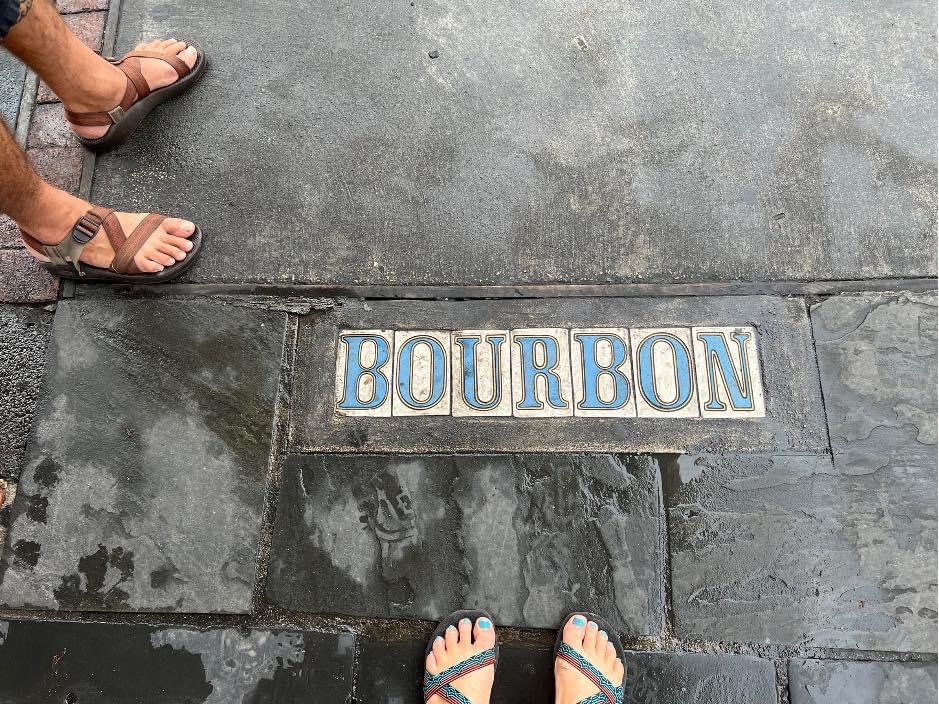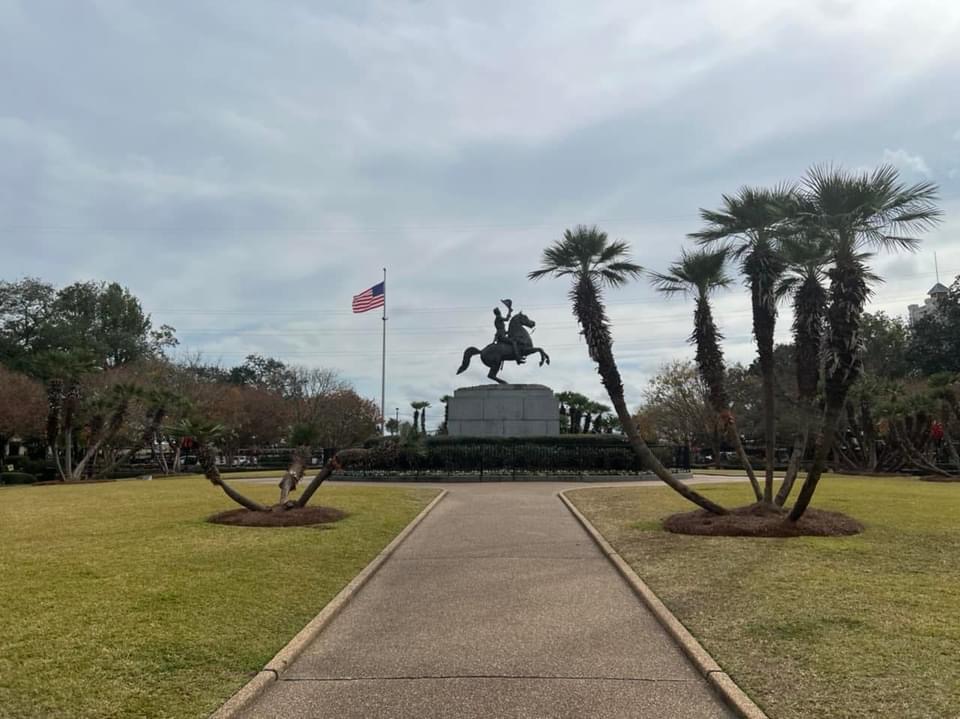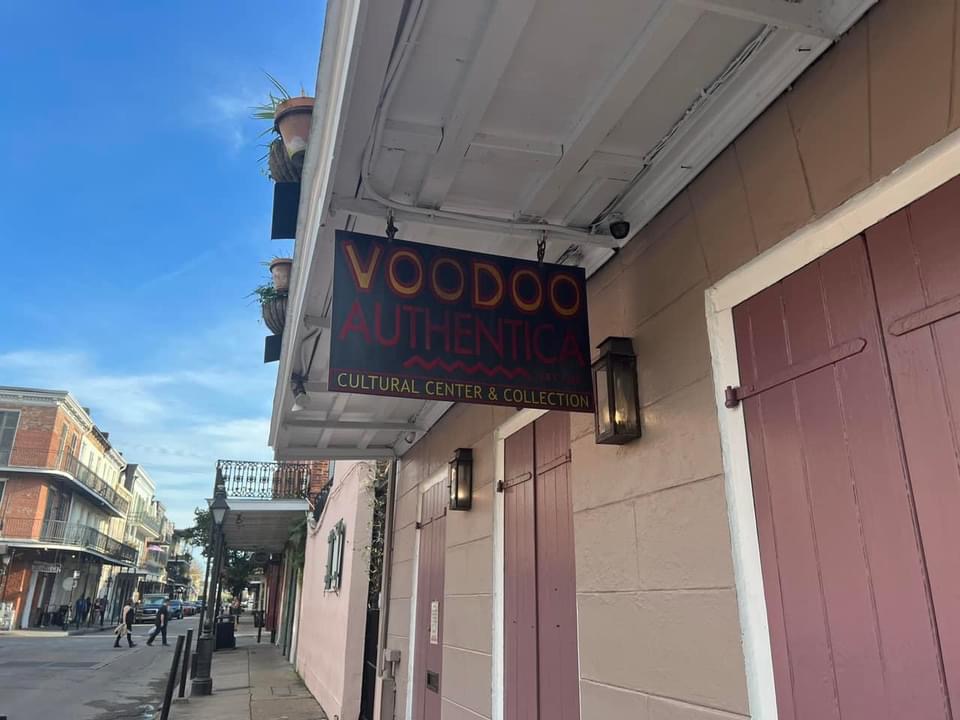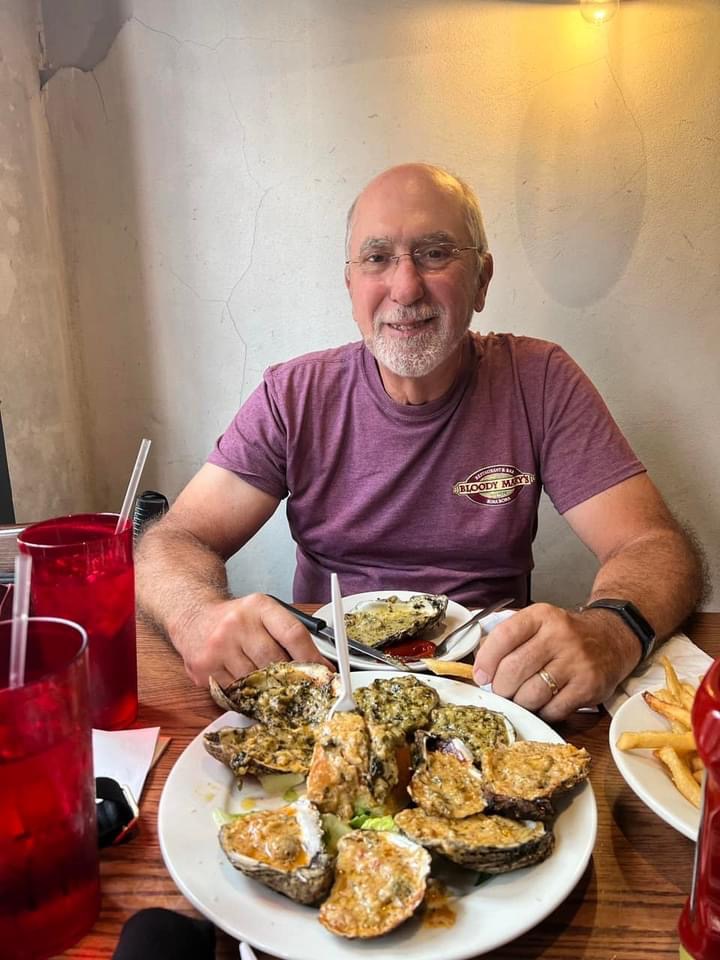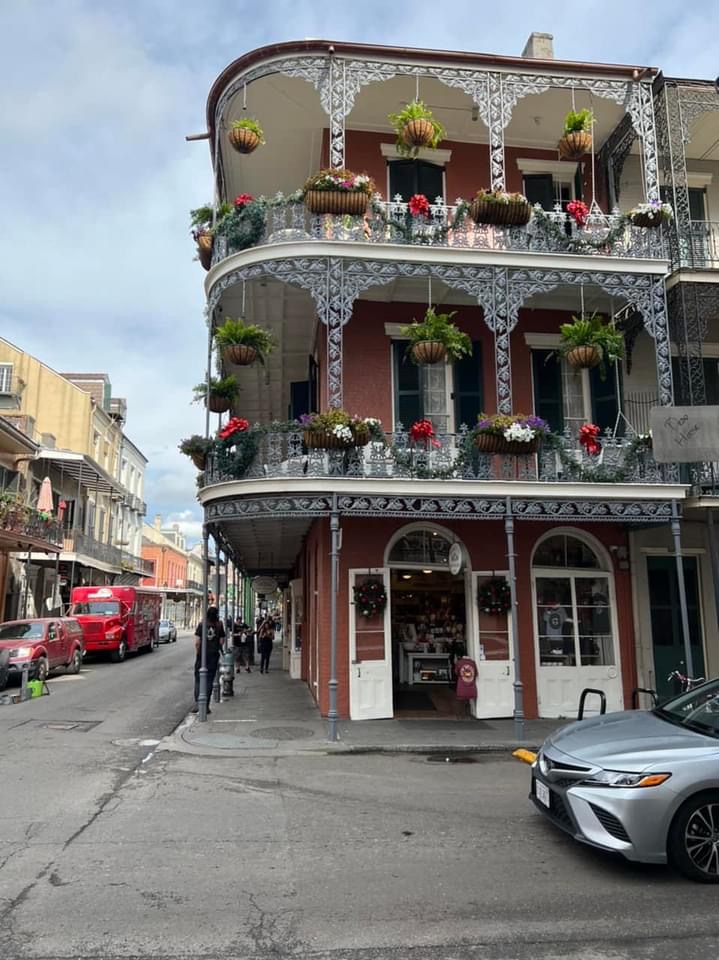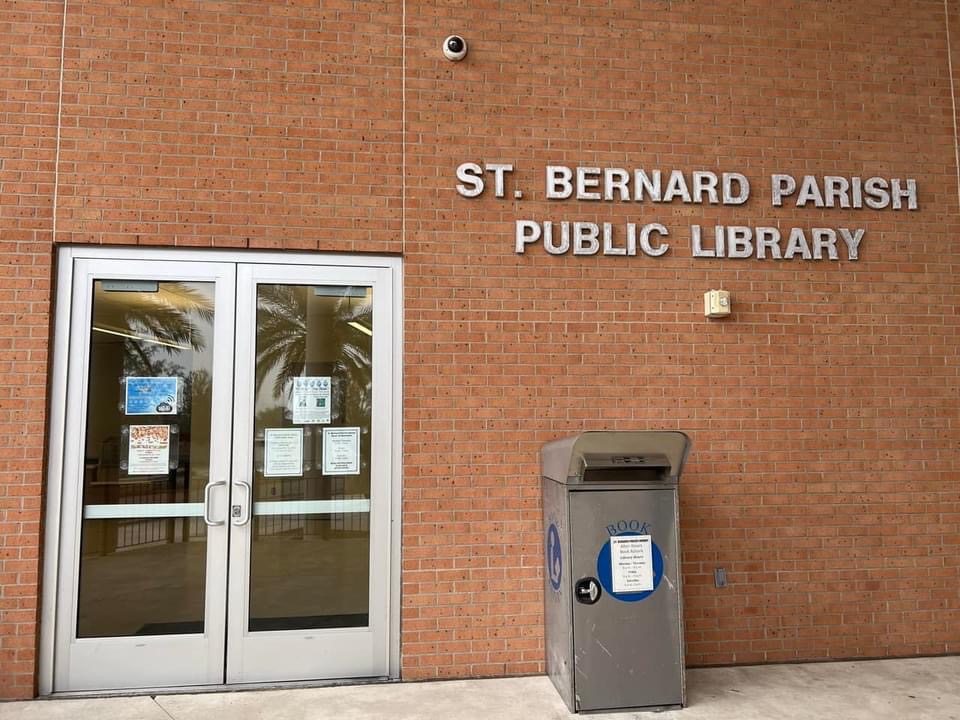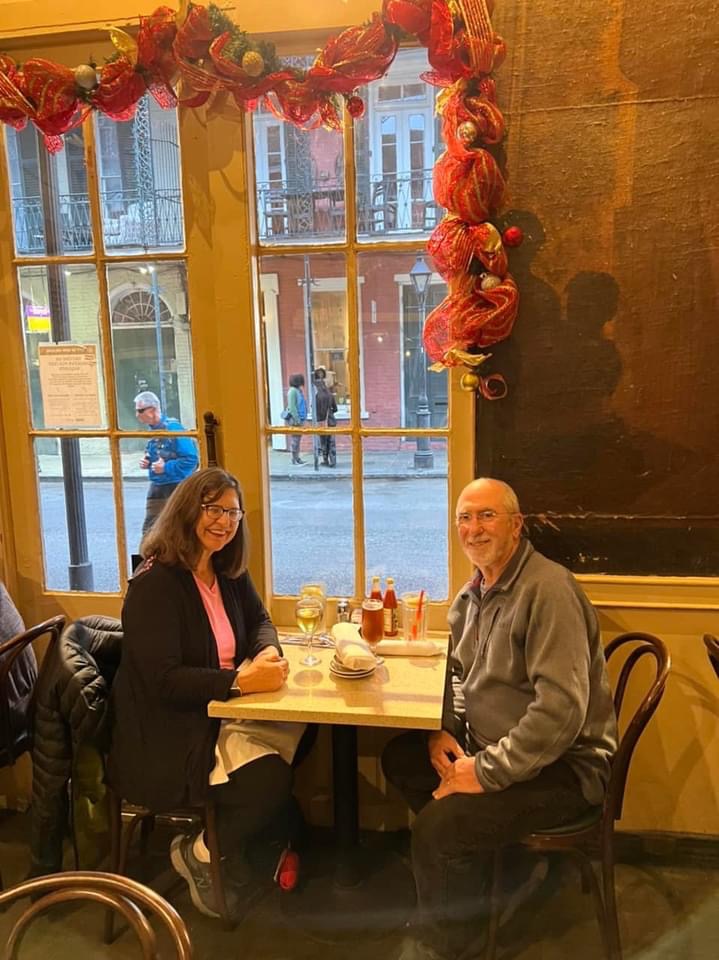IF YOU ARE READING THIS IN AN EMAIL, CLICK ON THE HYPERTEXT TITLE ABOVE TO READ IT IN BIGGER PRINT.
(Note: This blog entry represents a combination of writings and pictures already posted about our Cool Change II, Land Yacht Adventures 2021 through Cindy via Facebook and Rick via email. So for some of you, the following posts may be duplicative, but for others, this is the first time you are seeing them. We are repeating them here to centralize the record and share our experiences more broadly.)
COMBINED POST, WITH RICK IN PLAIN TEXT AND CINDY IN ITALICS:
Once we got the word on Thanksgiving night while along the Florida gulf coast that the death of my dear friend Chris was imminent, we immediately made plans to get ourselves to a place where I could catch an airplane to San Francisco, and Rick and the rig could be securely camped for as long as it took for me to get back. We decided that place was a public campground outside of New Orleans where we already had reservations. I couldn’t get a flight out until the Monday morning after Thanksgiving weekend, but we decided to drive straight through Alabama and Mississippi to get settled in Louisiana before my early morning flight. So all we got from Alabama was this photo!
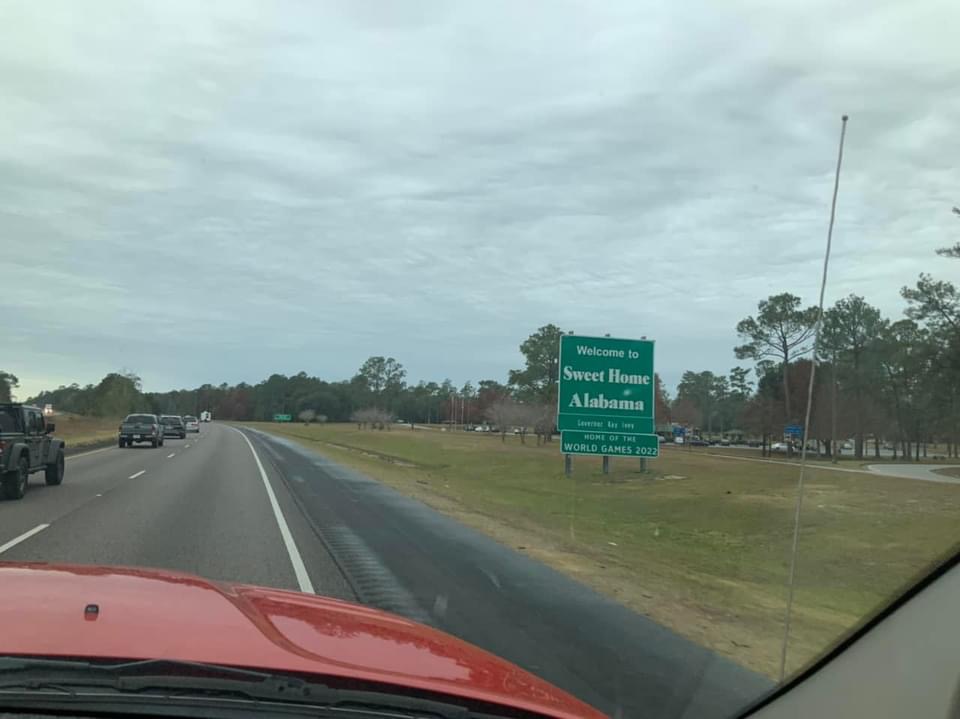
Since just little panhandles of both Alabama and Mississippi extend down to the gulf coast highway, we were able to drive out of Florida, and through Alabama, Mississippi and on to Louisiana in one day. We spent hardly any time in Mississippi either. However, we did meet a trucker in a diesel station in Mississippi who told us that while we were in Louisiana, we had to try Boudin. We did and it was wonderful.
Four states in one day:
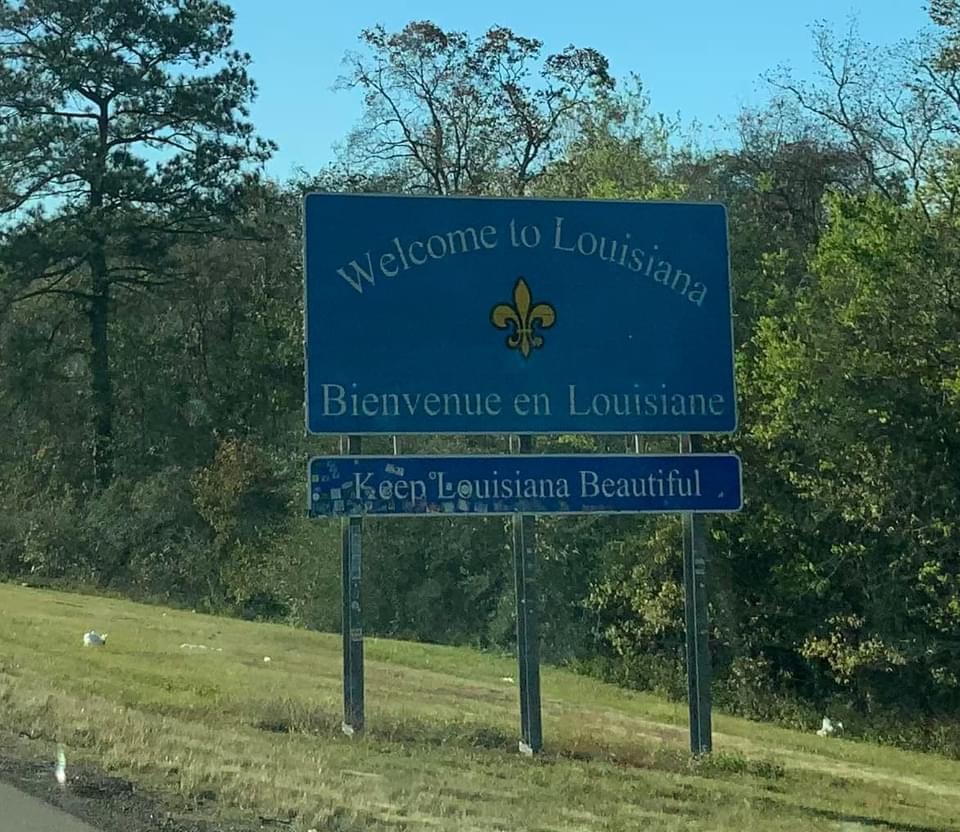
Having now travelled all along the Atlantic coast from South Carolina through Florida and then along the gulf coast to Louisiana, I am still trying to wrap my head around the fact that most of the land anywhere near either coast is mostly water. Swamps are everywhere, with berms and bridges creating dry ground for roads, neighborhoods and commercial buildings. New Orleans itself is pretty much surrounded by water, with no hills to speak of. No wonder it is so affected by storm surge. This is one of the bridges approaching New Orleans from the east:
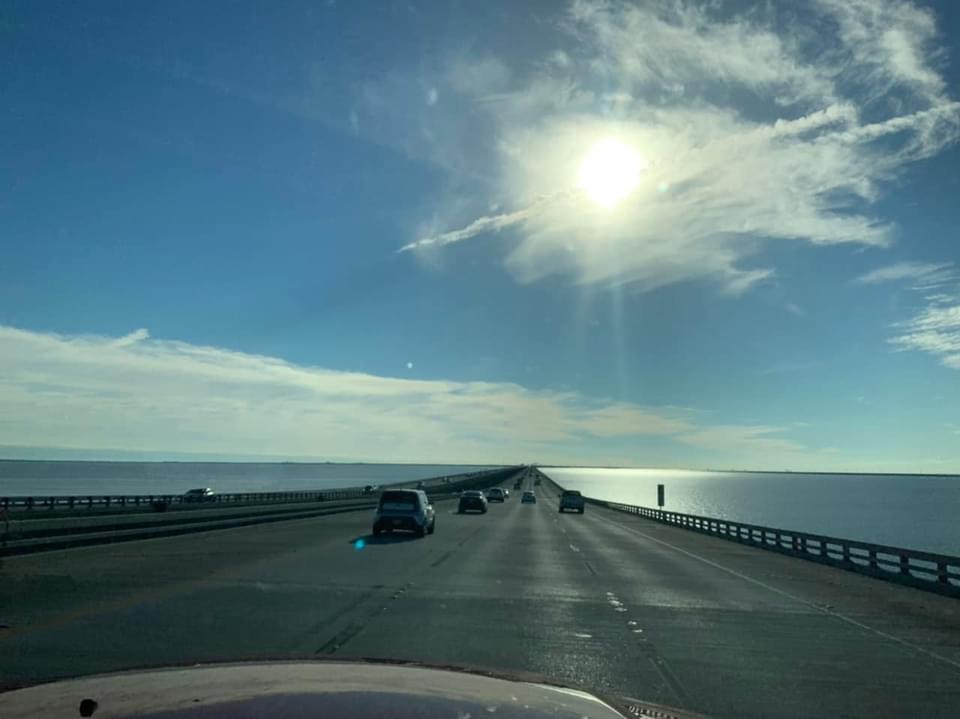
Our campsite at the state park in St. Bernard Parish was just east of New Orleans. It was a good place to leave Rick and the rig while I flew to San Francisco. We ended up staying there 10 nights. We had water, electric and sewer hookups at a senior discounted cost of only $13 per night. The bathroom and laundry facilities were right next to us. There were lovely nature trails throughout the park, and not that many bugs.
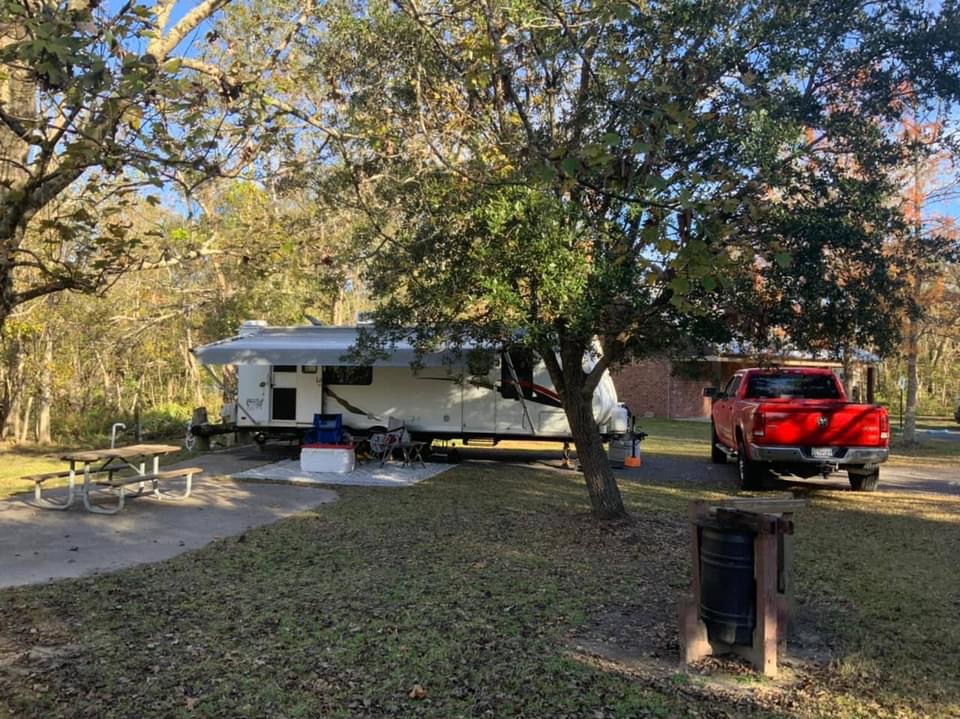
We made the right choice and felt well-rested the following morning as we headed out for the final 400 mile leg to New Orleans. We were going to be staying at a park near New Orleans called St. Bernard Parish State Park. It is located about 30 minutes from the French Quarter. Luckily, it was not a busy time of year for the park so when we asked, they allowed us to extend our stay. This allowed us the additional time we needed for Cindy to fly back to be with her friend Chris during her last days on earth, and with Roz, her wife.
The park is well maintained and we had a space right next to the showers with full hook ups and plenty of room. We got settled in and got to bed early so that we would be ready to head out early in the morning for the airport for Cindy’s 5 a.m. flight.
The drive to the airport through the city was kind of sketchy. It was still dark out when we left the park and we were driving through city neighborhoods for much of the way until we finally connected with the highway that lead to the airport. The neighborhoods looked pretty run down and there was much graffiti. The roads were in terrible condition and were full of potholes. The area had been hit hard by Hurricane Katrina, which was probably at least a part of the reason the area was so blighted. At one point we drove over a drawbridge with a lane so narrow I was wondering if we would make it across without scraping on the guard rails! We finally arrived at the airport where we said our goodbyes, and Cindy was off and on her way back to California. When I arrived back at the park it was still dark outside. This was definitely the low point of the trip for me. For the next week I was going to be alone while Cindy was going to be back in California. I hoped Cindy would get back in time to say goodbye to Chris, but regardless, I knew she would be a great help to Chris’s wife Roz during the difficult time ahead.


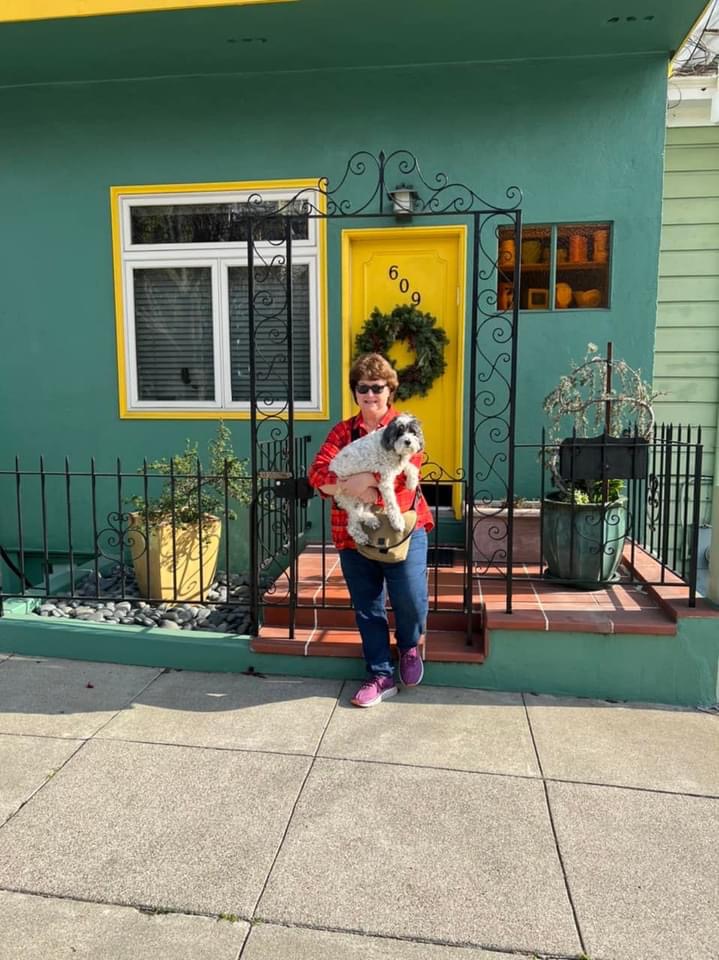
Chris’s surviving wife Roz,
also my close friend, in front of their San Francisco home, and their dog Kepler.
During the week Cindy was gone, I (Rick) did some exploring of the area and tried to line up some fun things to do when she returned. Because the roads were so bad, I had investigated how to get to downtown on the bus system but I found that it would take a couple of hours to get there with two intersystem transfers.
Looking at a map, I saw that there was a park on the way to the French Quarter called Crescent Park that looked like it might be a good place to park the truck. A riverfront walk ran from there along the Mississippi into the French Quarter. I decided it was worth a look, so I drove there one morning. When I pulled into the parking lot, there were a few vehicles already parked but I also noticed some broken auto glass on the ground from what looked like prior recent break in’s. It did not look like it would be a secure place to park at night but as it was still early in the day, I parked and walked along the two mile river path that lead into the French Quarter. It began with a wooden stairway up to a pedestrian bridge to get to the other side of the railroad tracks and down next to the river. From there, a wide paved path followed the river into the city. There were some abandoned loading platforms along the river walk that must have once been used to bring freight from the river boats to the trains.
At the end of the walk we’re the remains of a large warehouse that local people seemed to have put to use as a public roller skating rink. Farther on was another stairway leading over a pedestrian bridge to get back across the railroad tracks and return to the road. Once at the road again, just across the street, was the French Market that sells everything from vegetables to handicrafts and art.
From my first walk around the area, I thought we might actually be able to find places to park there when I came back with Cindy. I didn’t stay long because I kept thinking about the broken glass in the parking lot where I had left the truck!
When I got back to the parking lot, all was well and I drove back to our campsite. One thing that is odd about the outskirts of New Orleans is that the roads, in addition to being in very poor condition, are also laid out poorly. So much so that often I would be following a route on Google Maps and would have to make a U turn to get to a particular street I wanted to turn onto. The place where I would need to make the U turn seldom had a stoplight or a turn lane, making things even more difficult.
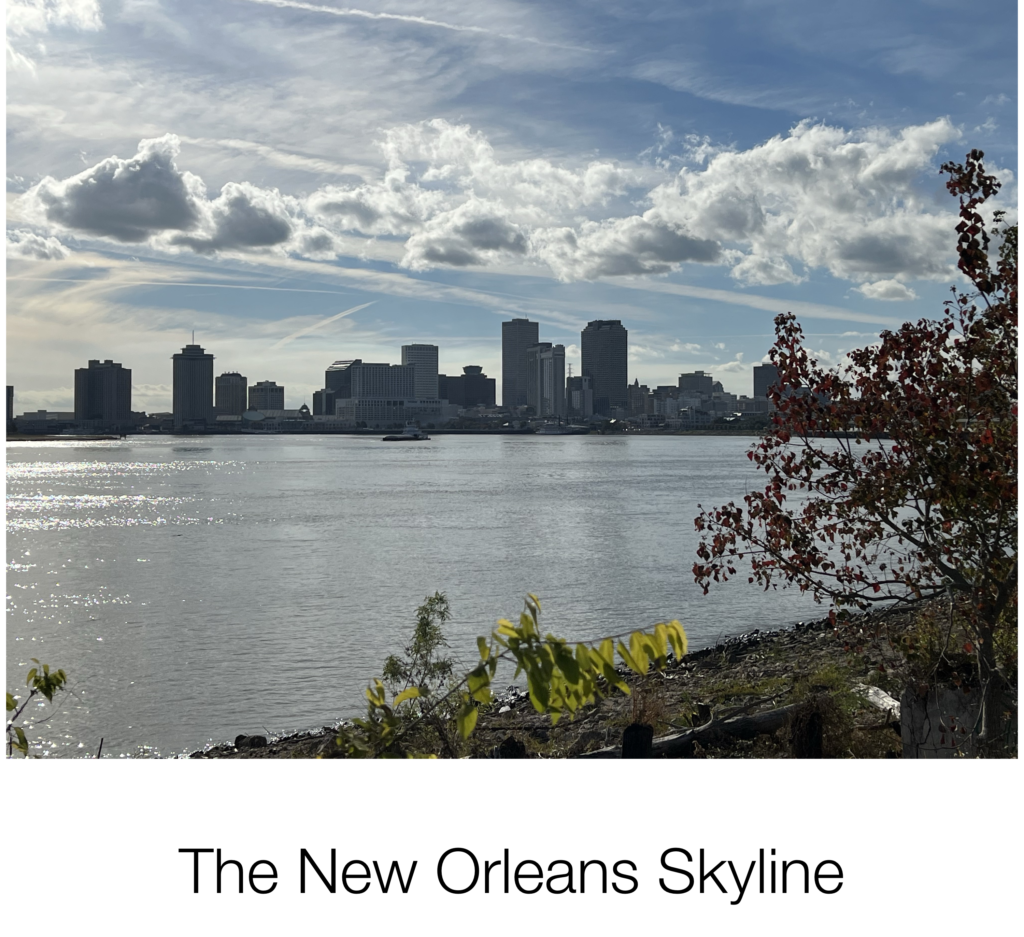
On my way home I stopped at a place called Charlie’s Restaurant and Catering that seemed to always have a lot of cars out front so I thought it would be a good place to try some local cuisine. I stopped in and ordered some Jambalaya and it was pretty good. The staff was friendly and the customers all seemed happy as well. This would be another place to keep in mind to bring Cindy to for experiencing some local color.
There was another place on the way back to the park called Casanova’s Seafood. I stopped by on another day to take a look. It was a small restaurant, mostly a takeout place, which also had a lot of local seafood such as crabs and crawdads that they would sell by the pound. I decided to fix Cindy a treat on her return so later that week I bought 6 pounds of crawdads. That may sound like a lot but those six pounds of bugs yielded no more than a half pound of meat by the time I had shelled and cleaned them. On top of that, it took more than an hour to do the work! So I planned a dinner for Cindy on her return using the crawdads in a salad along with crab cakes.

When Cindy did return from California, we had a few days left to spend in the area before we got back on the road. It had been a tough week for her but we both felt good that she had been able to be there for our friends.
There was a nice trail system in the state park where we were staying that meanders through the swamp. I had been exploring the trail system during the week and I was happy that Cindy was able to enjoy it when I took her out for a couple of hikes. The main trail goes on for about four miles and comes out near the entrance to the park. Along the way was an old swimming pool area that we could tell was once a big attraction for the public. It had been closed since it was destroyed by Hurricane Katrina. The whole area was fenced off and overgrown with weeds. All that remained of the pools were cement-lined holes in the ground filled with green water and debris. I had read that St. Bernard Parrish was hit hard by Katrina, with a loss of 163 lives.
Just past the state park are huge flood gates across the highway that could be closed in the event of a storm surge on the Mississippi. It is part of a system of 23 miles of flood walls along the Mississippi that have been constructed in the wake of Hurricane Katrina. Past the flood gate, the houses in the area along the river have been raised up on huge cement columns to put them above where an expected future storm surge could reach. We took a ride through the area and found it hard to imagine that people would choose to be there if they had any alternative.
We drove into the French Quarter the next morning. We easily found a great place to park and went out to do some exploring. We walked through the French Market and ended up at the infamous Cafe Du Monde, where we enjoyed some coffee and beignets.
There was a New Orleans Jazz band performing out on the sidewalk in front of the Cafe and that was really fun. Across the street was a woman dressed in some type of crazy colorful costume and dancing to the music. Cindy took her photo and felt obliged to leave her a tip.
From there we walked a short way to Washington Artillery Park to begin a self-guided walking audio tour of the area.
It took us through the Park and up Charles St. where we saw the building that housed the Slave Exchange, which was built in 1788. Andrew Jackson met with the Lafitte brothers there (local pirates) to make plans for the battle of New Orleans. He offered them clemency for their participation, after which they soon went back to their plundering ways. Nearby is the building that houses the Louisiana State Supreme Court.

Reflecting Louisiana’s history of being under foreign rule, the street names in the French Quarter all display the Spanish name for a street on a wall, the French name on the curb and the English name on the street sign!
There was a pharmacy museum we passed, which unfortunately was closed. Our audio tour explained that in 1800’s New Orleans, all pharmacies would place a bust in the window displayed with a tongue sticking out to indicate they were a pharmacy.
There are old horse troughs along the streets that are still in use today by the horses that pull carriages with tourists through the area. We passed the oldest building in New Orleans, currently operating as a pub and formerly a Blacksmith’s shop owned by the Lafitte brothers.
We visited a Voodoo store that is owned by current Voodoo practitioners. We learned that Voodoo was not the black art it has been made out to be but was actually a blend of Catholicism and African religions that had to be practiced in secret. There was a law passed in 1685 that forbade the practice of African religions and required all masters to Christianize their slaves within eight days of their arrival. Voodoo dolls and their associated pins came about not to curse people, but rather as a method used by a Voodoo practitioner to remember the locations of ailments in patients that they were treating.
Of course no tour would be complete without a walk down Bourbon Street. We found the restaurant called Mambo’s that a truck driver we had met in Mississippi had recommended. He had also recommended a classic New Orleans dish called Boudin. It is a sausage made of rice pork and a spice blend that is just amazing. On this visit for lunch though, we went with the Oysters Rockefeller and Mambo’s Famous Oysters, which were a real treat as well.
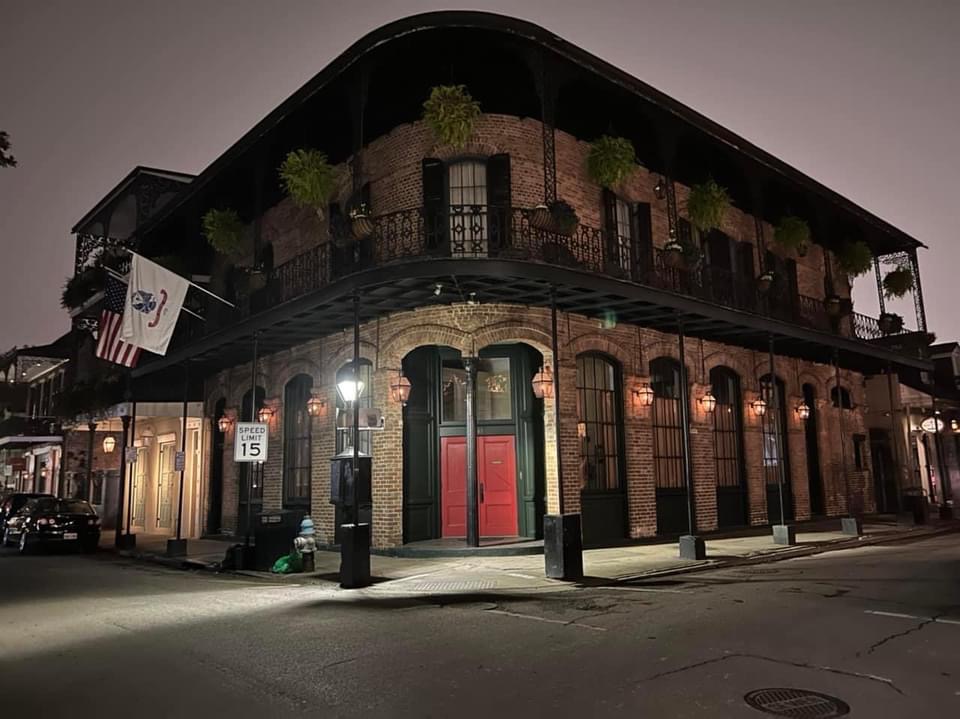
gaslight lanterns on many buildings in the French Quarter 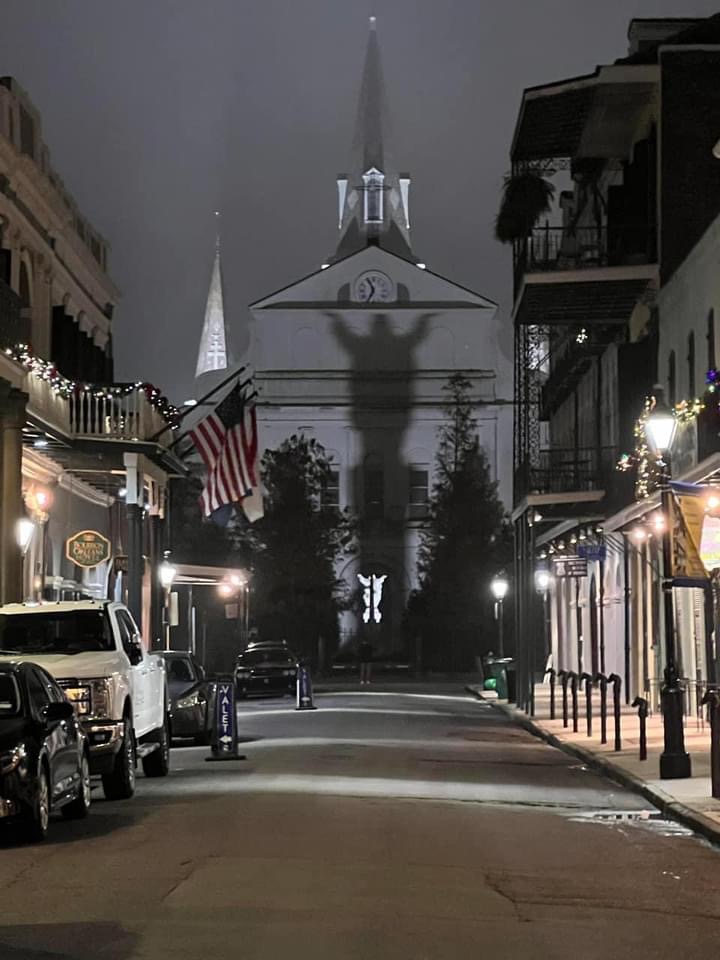
The eerie shadow on the back of the St. Louis Cathedral 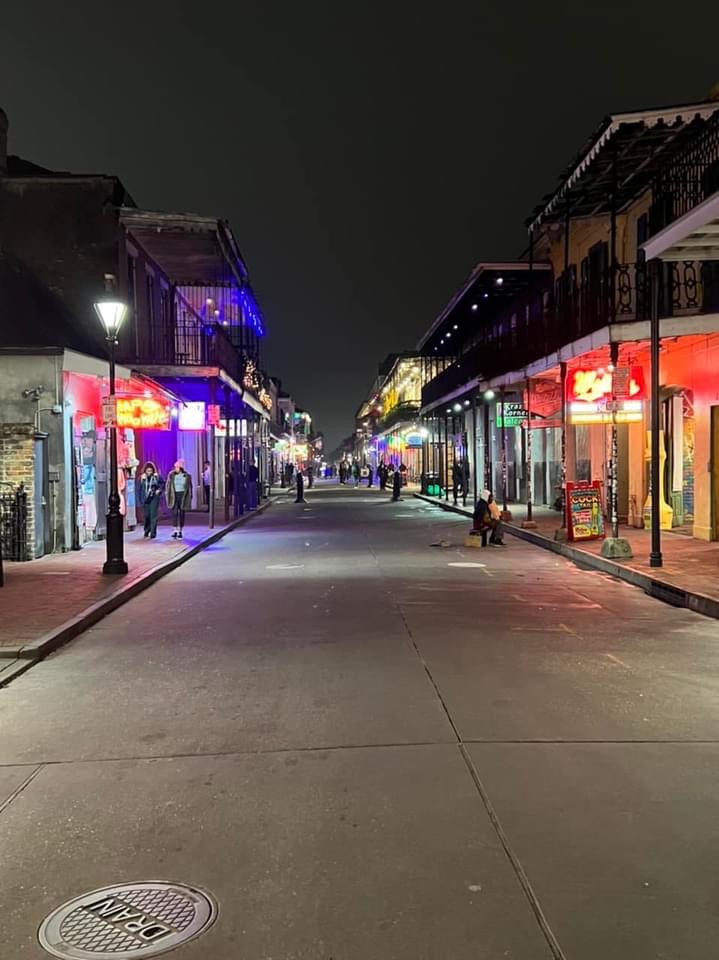
Early at night on Bourbon Street
One of my favorite things about New Orleans is the wrought iron work on the balconies along with the beautiful plants that adorn them. It is such a beautiful sight to see.
After a long day on our audio tour, we went to a wine bar outside of the French Quarter called the Bachanal. This was on another tip from my sister Elena. It was a bit of a walk well out of the quarter and it had started to rain and get dark while were on the way there. When we arrived, the host brought us upstairs to a table in the dining area where there would soon be some live entertainment. He said we would need to go back downstairs to a room that was essentially a wine and cheese market and pick out and pay for what we wanted to be served. We decided on our wine and cheeses and then went back upstairs. Our choices were then plated and delivered along with bread, crackers, olives and other treats. It was an unusual experience. Then the band started playing, which was a jazz band playing the type of jazz that I have always found annoying. It is free form and to my ear, seems like everyone is playing a different song at the same time. I just don’t get it! But regardless, we had a fun and memorable visit. When it was time to go, as it was very dark by now and still raining, we caught an Uber back to the truck.
It had been a huge day in New Orleans so we spent the next day at the campground.
We returned the following day to the French Quarter to go through the market to buy some presents, and to do some more exploration.
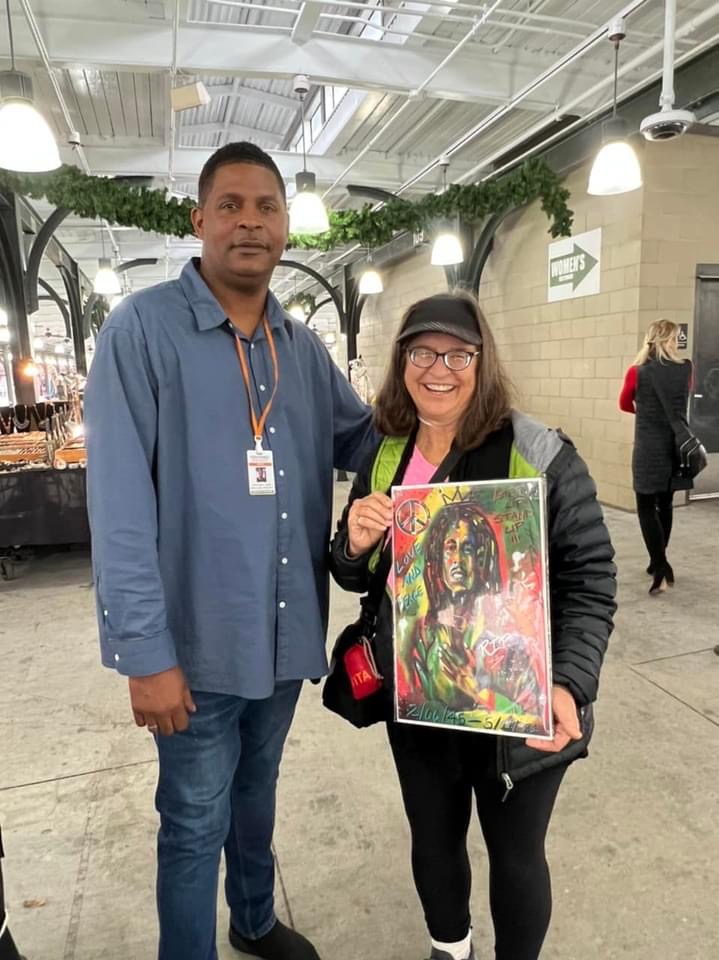
We started later in the day this time, and after some exploration and shopping, we went for an early dinner at a restaurant called The Gumbo Shop we had seen on our first visit. It was a very popular restaurant but we arrived at a good hour when it wasn’t crowded and we didn’t need reservations. This was where we finally had our Boudin as an appetizer along with some étouffée, shrimp creole and jambalaya.
Finally, we ended up at the Carousel Bar, which as the name implies, is a rotating bar located inside of a very chic hotel called “The Monteleone.” My sister Elena had told us that the Carousel Bar was not to be missed. The bartenders there were really good and it was fun to watch them perform as they made some New Orleans classics such as “The Hurricane,” which I had. Cindy ordered another signature New Orleans cocktail called a Sazerac. Even though it was mostly hard liquor straight up, she liked it.
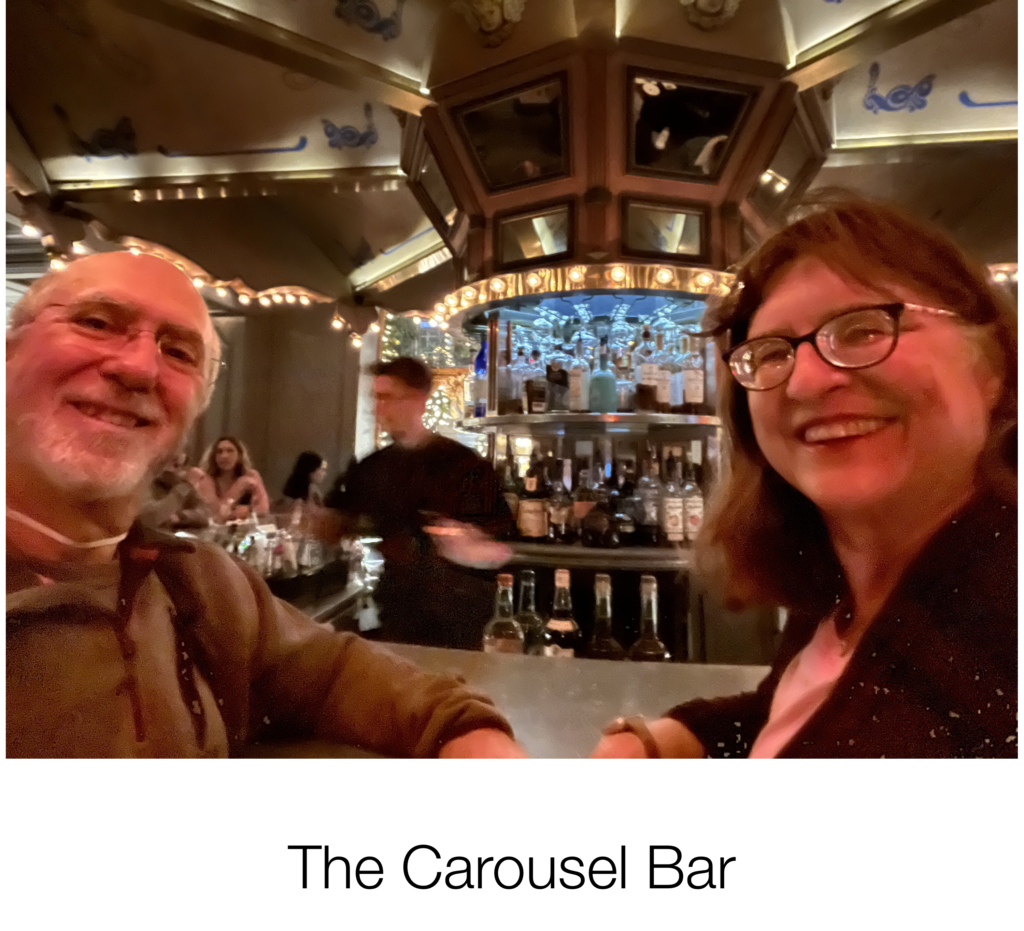
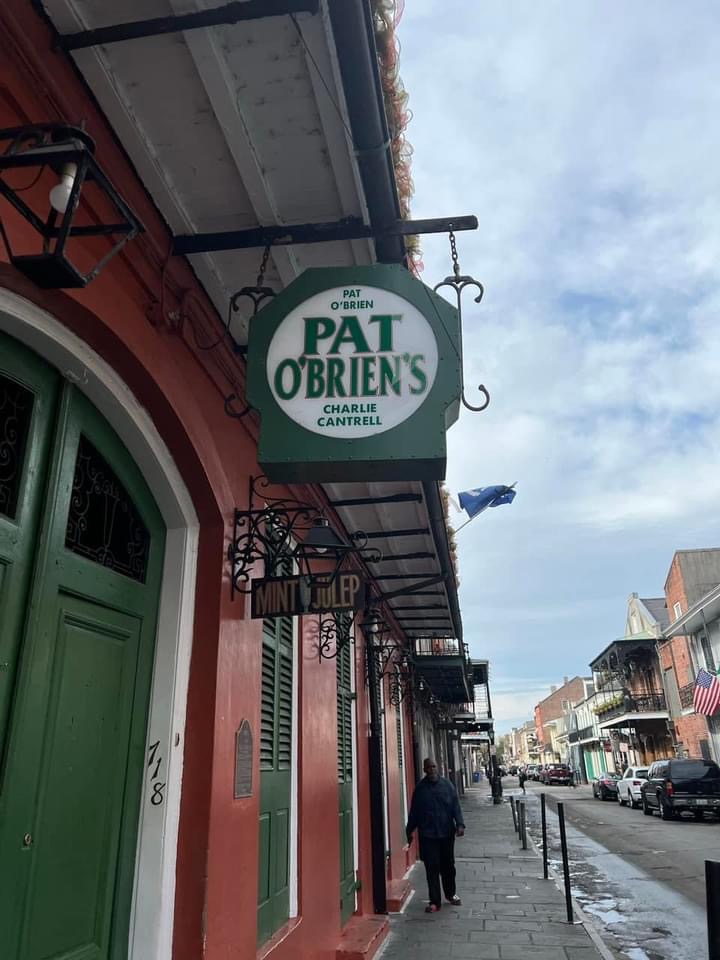
Home of the famous New Orleans “hurricane,” a fruity rum drink originally designed to obscure how bad the rum really was.
In the morning we would be leaving New Orleans and spending one more night in Louisiana before crossing into Texas. The main purpose of our visit to Texas would be to have a visit with our eldest daughter Andrea, her husband Josh, daughter Teagan and son Sam. They live in Justin, Texas, in the Dallas/Ft. Worth area. We had reservations nearby their home at Northlake Village RV Park in Roanoke, Texas. The drive to Roanoke from New Orleans was 560 miles and we were going to take three easy days to get there. Our first stop would be at a campground near Boyce, Louisiana called Cotile Recreation Area, about 225 miles from New Orleans.
Boyce, Louisiana is a small town in Rapides Parish, Louisiana. If you have ever wondered, as I did, why Louisiana uses the term “parish” rather than “county” to delineate those boundaries, it has to do with the fact that Louisiana was mostly Roman Catholic at various times under the rule of both France and Spain. In 1807 the territorial legislature officially adopted the use of “parish,” which at least at that time identified the boundaries included in a church parish. Louisiana is the only state that has adopted parish boundaries.
A few miles outside of Boyce, Louisiana is a beautiful lake and recreation area known as Cotile State Recreation Area. We had made reservations to spend the night there.
We arrived late in the afternoon, and went into the office to check in and pay for our site. This facility did not have any online or cash payment system so we actually had to write them a check on arrival. It was one of just a few times we have needed a check on this trip but we were glad we had one to use. The campground manager explained that the park had been hard hit by a hurricane in 2020 and that they were still working to recover from the damage it had inflicted. Most of the facilities in the campground remain closed as a result, and there were many downed trees that crews were actively working on cutting up and clearing. He told us that some of the campsites were barricaded due to hazardous conditions. That said, there were not a lot of campers in the park at the time so he suggested we should drive around to find a spot that we liked.
While we were in the office, Cindy noticed that there was a photo on the wall of a large alligator stretched out in front of the office. The manager confirmed that it was caught on a hunt there and that oh yes.. the lake was chock full of them!

While we were chatting, our host mentioned another thing that is peculiar to Louisiana. The laws in Louisiana are based on a version of the Napoleonic code. This again dates back to when the territory was under French rule. Our host’s interpretation of the code was that in Louisiana, a person is guilty until proven innocent. He mentioned this as an explanation for why they didn’t have much crime. Out of curiosity, we did some research and found that this really is not the correct definition. Rather, the Napoleonic code really means that Louisiana follows a system of civil law vs. common law. In a nutshell, this means that a judge in Louisiana decides a case based on his or her interpretation of the law, rather than the decisions that set a precedent in case histories of other courts. In addition, Louisiana has a legal principal called “forced heirship,” which states that an heir is legally guaranteed a portion of their parents’ estate.
We drove through the campground and found a really beautiful site that overlooked the lake. It was tight backing in but it it had a nice deck with a railing out in front. The railing was essential, because without it, a person could easily take a tumble down the hill towards the water (and hungry gators?). We really loved the beauty of this place. We sat outside as the sun went down and contemplated whether we should stay another day and then drive the rest of the way to our next destination, Roanoke, Texas, in one day rather than two.
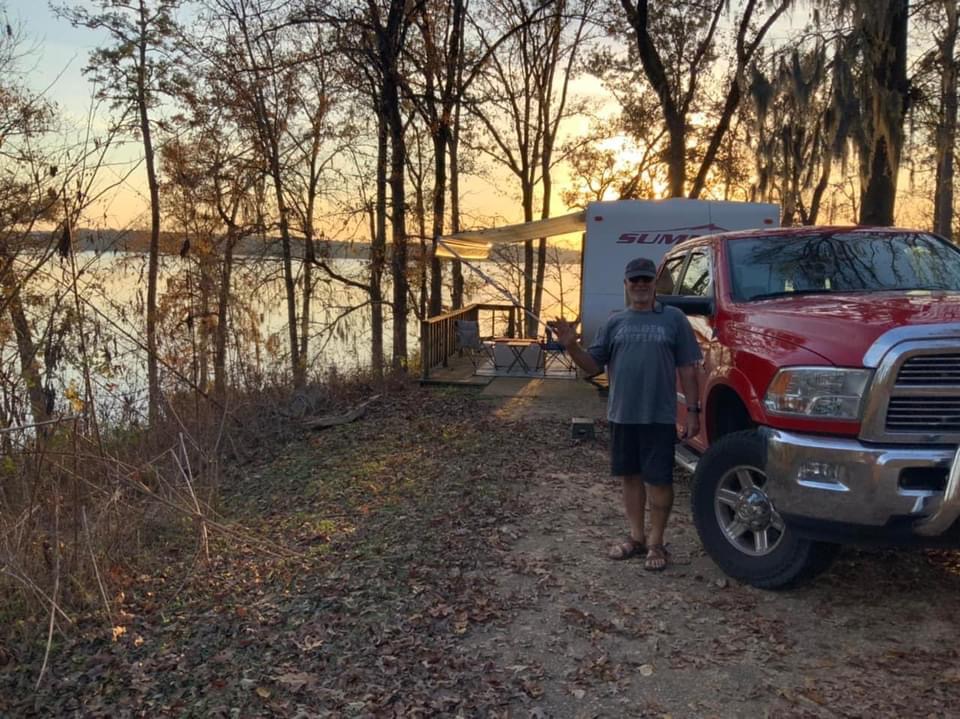
In the morning we went for a long walk through the grounds; the damage from the hurricane became much more evident. There were signs of the damage just about everywhere. We walked down to a beach, (No swimming allowed) and to the boat launch. At the launch was a long dock we walked out on with a nice bench at the end of it where we sat and enjoyed the view of the lake. The lake was manmade, and we could easily see this because the water this year was low and there are stumps sticking up all over that section of the lake. By the time we had finished our walk, we decided that we should move on. In short, the lake was filled with stumps and alligators and though the view from our spot was amazing, there was not much more to see.







